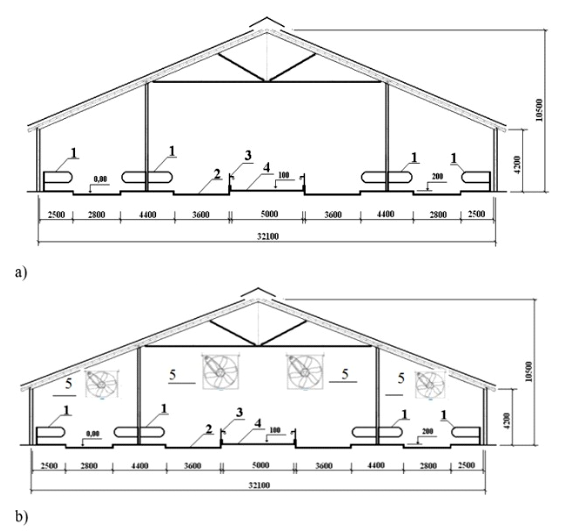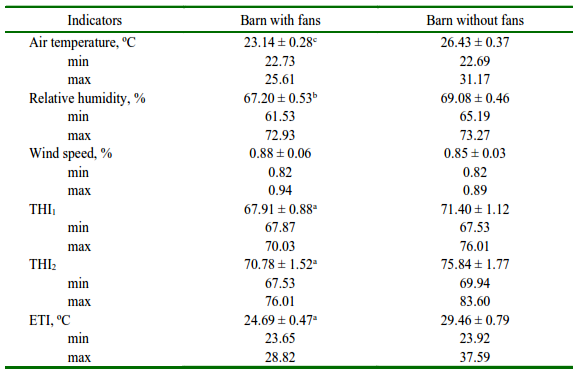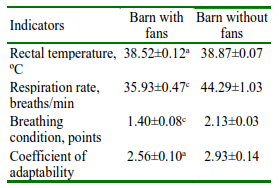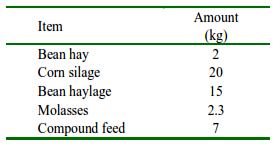INTRODUCTION
Global warming and its associated factors have a significant impact on the economics of milk production and the welfare and health of dairy cattle (Negrón-Pérez et al., 2019; Giannone et al.,2023). At thesame time, the method of keeping, the parameters of the premises and technological solutions in the middle of the premises significantly affect the reaction of the animal body caused by temperature fluctuations (Fedota et al., 2022; Ruban et al., 2022).
During recent decades, dairy cattle have been increasingly exposed to high temperatures, especially in temperate countries (Central and Eastern Europe) (Borshch et al., 2019; Ruban et al., 2020). For highly productive dairy herds, the impact of high air temperatures should be assessed in combination with indicators such as relative humidity, wind speed, insolation and atmospheric pressure (Atkins et al., 2018; Borshch and Borshch, 2022; Nzeyimana et al., 2023). The interaction of these climatic factors significantly affects the behavioural, reproductive, produc-tive signs and clinical characteristics of dairy cows (Borshch et al., 2021; Mylostyvyi et al., 2023). Various studies have shown that raising of the air temperature up to +30 ºC and above leads to a decrease in milk productivity of cows from 8 to 35% (Bernabucci et al., 2014; Wijffels et al., 2021; Frigeri et al., 2023). In addition, during periods of high temperature stress there is increase of the body temperature, respiration rate and assessment of respiratory severity (Ruban et al., 2020).
Heat stress affects the productivity of cows depending on the phase of lactation. In particular, at the early stages of lactation cows are less able to counteract the adverse effects of heat stress (Yadav et al., 2019; Bokharaeian et al., 2023; Moore et al., 2023). Negrón-Pérez et al. (2019) found that high temperatures most adversely affect the productivity of cows during the first 60 days of lactation.
To reduce the negative impact on productivity, reproductive function, health and comfort of cows, different technological approaches are used at farms. First, these are systems of forced ventilation and cooling of animals (fans and irrigation systems), use of mattresses for rest with pumping of cooled water through them, use of feedlots with canopies for rest and feeding, and their combinations (Calegari et al., 2014; Borshch et al., 2022). Fans that hasten air movement and enhance convection can lower ambient temperatures and relieve heat stress by decreasing animal respiration rates, rectal temperatures, and boosting dry matter intake (Chang-Fung-Martel et al., 2021; Oliveira et al., 2025).
Most research in this area conducted at farms where the study of the impact of fans on productivity, comfort and welfare of cows was investigated in combination with water irrigation (Summer et al., 2019). Such combinations allow reducing of the effect of heat by 84%. At the same time, the values of respiratory rate and rectal temperature decrease. Therefore, the aim of this work was to study the impact of fans used during the periods of high temperature load on the microclimate in the barns, productivity, milk composition and clinical characteristics of cows.
MATERIALS AND METHODS
The study was conducted at a commercial dairy farm located in the central region of Ukraine, specifically in the Kyiv region at coordinates 49°512 273 N and 30°62 363 E. The dairy cows of Holstein breed were housed in two similar easy-to-assemble barns, accommodating a total of 300 animals. One of the cowsheds used fans (20 per room), and the other was without fans. Fans (Multifan, Vostermans Ventilation, the Netherlands; production capacity up to 48000 m3/h) are located above the aft and manure passages (Figure 1). The fans in the barn remained operational from 10:00 to 18:00 h, running continuously for eight hours. Parameters of placements (L×W×H): 94×32.1×10.5 m.

Figure 1. Easy-to-assemble barns without (a) and with (b) fans. 1 - boxes for cow’s rest; 2 - feed and manure alley; 3 - feed passage fences; 4 - feed passage; 5 - fans
A group of 32 non-pregnant cows in the third month of lactation (82 ± 17 days in milk) was specifically chosen and allocated to each of the cowsheds. Cows were milked three times per day at the parallel installation (DeLaval 2×16, Sweden). Daily milk yield was recorded using the DelPro herd management system. A general view of the barn (from a side view) and the fan are shown in Figure 2.
The research was conducted during July 2021 in thermo-neutral (average daily temperature 19.8 ºC, 12 days) and hot (average daily temperature 27.5 ºC, 9 days) periods (Table 1). Cows were provided with a total mixed ration (Table 2) two times daily at 09:00 and 19:00 hours.
Environmental and physiological data were recorded as follows:
Rectal temperature (veterinary thermometer Microlife VT1831, Switzerland) and respiratory rate (using a panting score scale ranging from 0 to 4.5, as defined by Gaughan et al. (2019) twice a day after morning and afternoon milking. Temperature and relative humidity were monitored using the Voltcraft DL-141 sensor (Germany). The sensors were positioned at a height of 0.5 m above the floor where the cows were located. Measurements were automatically recorded every 10 minutes. Breathing condition and corresponding respiration rate were assessed using a panting score scale ranging from 0 to 4.5, as defined by Gaughan et al. (2019).
Wind speed inside the barn using a handheld pocket digital anemometer (AZ air flow meter, Taiwan).
Temperature-Humidity Index (THI1 and THI2) was calculated according to NRC (2001) and Zahner et al. (2004): THI1 = (1.8× T +32) -(0.55 -0.0055× RH)×(1.8 × T -26) and THI2 = 0.8 × T + RH/ 100 × (T -14.4) + 46.4, where: T, Air temperature (ºC) and RH, Relative Humidity (%).
The Equivalent Thermal Index (ETI, °C) was calculated according to Baeta et al. (1987): ETI = 27.88 -0.456 × Tair + 0.010754 ×Tair 2 -0.49505 × RH + 0.00088× RH2 + 1.1507 × WS -0.126447 × WS2 + 0.019876 × Tair × RH -0.046313 × Tair × WS, where: WS,- average wind speed (m/s). ETI values are considered as representing a damaging risk to animals: noproblem:18-<27ºC;caution: 27-<32ºC; extreme caution: 32-<38 ºC; danger: 38<44ºC; extreme danger: >=44 ºC (Gosling et al., 2014).
Coefficient of adaptability (CA) was calculated according to Benezra (1954): CA= RT/38.3+ RR/23, where: RT - rectal temperature (ºC); RR - respiratory rate (breaths/min). It was considered 38.3 °C and 23 rpm as average values of body temperature and respiratory rate in optimal conditions.
-Milk yield and characteristics was assessed based on daily yields. Milk samples were collected from each cow three times per day (morning, afternoon, and evening) for consecutive days. Milk fat, protein, and lactose content were determined using the Milkotester Lactomat Rapid S device from Bulgaria.
The net energy content (NEL) of milk was calculated using an equation derived from the one proposed by the National Research Council (NRC) in 2001: NEL (Mcal/kg) = 0.0929 × fat, % + 0.0547 × protein, % + 0.0395 × lactose, %. The NEL values obtained were converted to MJ kg-1.
All data are reported as means ± standard error of the mean. The statistical significance of the obtained values was evaluated using Student’s t-test. Data were considered significant at ap<0.05, bp<0.01, and cp<0.001. A Student’s t-test was conducted to compare the means between the barns with and without fans. These statistical analyses were performed by STATISTICA software (version 11.0, 2012).
RESULTS AND DISCUSSION
The use of fans in barns during periods of high temperature load had a positive and significative effect on the microclimate and the values of the three temperature indices (Table 3). Average temperature and relative humidity in the barn with fans were 3.29 ºC and 1.88% lower compared to the barn without fans. Lower values of THI1 and THI2 (by 3.49 and 5.06) and ETI (by 4.77 ºC) were also observed. These results are consistent with the study of Almuhanna et al. (2021), which show that the use of fans has influenced the reducing of temperatures and THI in barns.
Table 3. Microclimate and climatic indices in barns with and without fans during hot period

ap<0.05; bp<0.01; cp<0.001 as compared with barn without fans
The average index of daily rectal temperature for keeping in a barn with fans was 0.35 ºC lower compared to a similar barn without fans (Table 4). In addition, the use of fans affected respiration rate and breathing condition in cows, which were lower by 8.36 breaths/min and 0.73 points, respectively.As for the coefficient of adaptability, it was also lower in the barn with fans (by 0.37).
Table 4. Clinical parameters and breathing condition of dairy cows during a hot period

ap<0.05; cp<0.001 as compared with barn without fans
The temperature stress usually affects milkyield, cows’fertility, and milk quality, thus leading to decreased profit for farmers (Becker et al., 2020). Heat stress in dairy cows causes an excess of reactive oxygen species and mitochondrial dysfunction, resultingin oxidative stress, thus reducing milk protein production (Guo et al., 2021). According to Sammad et al. (2020), heat stress impacts issues with insulin, glucose metabolism, fat mobilization, and muscle metabolism, and therefore these could be key factors in heat stress-related energy imbalance. To counteract some of these effects, the use of fans was found to have an effect on lowering body temperature in dairy cows during hot periods (Ortiz et al., 2015; Becker and Stone, 2020; Pakari and Ghani, 2021). Besides, the results of the present study partially match with those of Meyer et al. (2002), who reported about a decrease in respiration rate per minute of lactating cows when kept indoors with fans located above the feed table. Calegari et al. (2014) in Italy also indicate that the use of fans in combination with water irrigation systems in barns during periods of hot temperatures reduced respiration rates of cows.
It was found that the use of fans in the barn during the hot period had a positive effect on the average daily milk yield, milk composition and its energy value (Table 5). Productivity of cows kept in a barn with the use of fans during the hot period decreased by 0.37 kg (1.45%) while in the barn without fans the decrease constituted 2.64 kg (10.22%) compared to the thermo-neutral period. With regard to the main components of milk, during the hot period there was a sharp decrease in fat, protein and lactose (by 0.11, 0.06 and 0.07%, respectively) in the barn without fans as compared to less decrease in the barn with fans (0.03, 0.02 and 0.03%, respectively). Accordingly, there was an extreme decrease in the energy value of 1 kg of milk during the hot period for keeping in a barn without the use of fans as compared to the barn with fans (by 0.063 vs. 0.017 MJ).
Table 5. Milk yield, composition and energy value of 1 kg milk of dairy cows during thermo-neutral and hot periods

ap<0.05; bp<0.01; cp<0.001 as compared with hot period
Numerous studies indicate the effect of high temperatures on the total yield of milk fat and protein per lactation (Smith et al., 2013; Bernabucci et al., 2014; Mauger et al., 2015). On this, Nasr and El-Tarabany (2017) indicated that when THI decreased from 80-85 to 70 and below, fat content also decreased by 0.17%. Moreover, in the studies of Gao et al. (2017), cows during the period of heat stress reduced the total yield of milk protein by 19% compared to the thermo-neutral period, being one of the reasons a decrease of feed intake.
CONCLUSIONS
The use of fans in barns during the hot period had a positive effect on the microclimate (temperature and relative humidity) and climatic indices (THI1, THI2 and ETI).
Fans exert a positive impact on various physiological of cows such as rectal temperature, respiration rate, and breathing condition.
During hot periods the cow’s average milk yield and energy values of milk in barns with fans were significantly higher than in non-fan-equipped barns.












 uBio
uBio 





